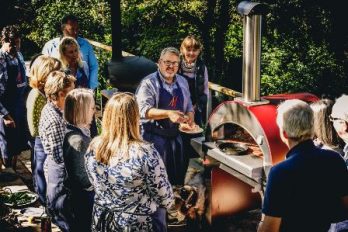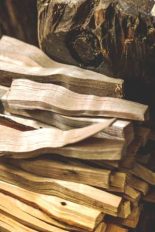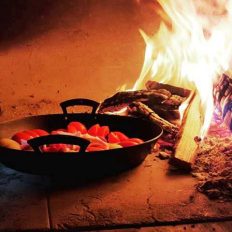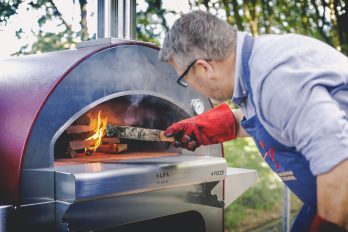Temperature Management in the Woodfired Oven
We love seeing so many of you here at the cooking school on our woodfired courses; it’s fantastic how this cooking we love is really growing and becoming increasingly mainstream.
One question always seems to crop up when we ask people what they really want to get to grips with – and that’s fire management and temperature control. Being able to manage your fire and the oven temperature will just make everything much calmer and you’ll have control over what you’re doing, making it a more enjoyable and less stressful experience for all concerned!
Here’s a few hopefully handy tips to help you on your way –
- Make sure your wood is hard wood and is less than 20% moisture content. You can check this with a moisture meter. We ideally want something around the mid-teens and we prefer to use a kiln dried wood from a reputable source. Damp wood will take time to ignite, meanwhile the temperature will fall. Dry wood will ignite readily giving more control.
- When your wood arrives it will come in pieces that are too big for easy fire management. Our logs usually arrive in pieces that are about 10cm in diameter, sometimes bigger. Make sure you take some time to split these down with a good axe before you start cooking. It’s much easier to do this before your cooking session rather than half way through.

- Some woods are denser than others so are harder to split so for eg oak, you’ll need a heavy duty axe to get through it. Alder, birch and ash are easier to split with a lighter axe.
- Keep your wood undercover so that it doesn’t absorb lots of damp or rain – a common occurrence in the UK climate for sure; probably not such an issue for those of you in drier climates like Arizona, say.
- When you are starting your fire, keep the stack of wood in the oven close to the oven door so it can access lots of oxygen and get a good fire burning before you push it further inside. We make a jenga stack of small split pieces of wood and get that really burning well, adding more as the fire takes hold. The top down method is also popular.
- When adding fresh wood to the fire, make sure it is placed loosely on the fire. leave space for air and flame to move around the fresh wood and it will catch quickly. If you pack the fresh wood on tightly and it will be starved of oxygen and take an age to ignite.
- Make sure nothing blocks the air from getting to your fire. Wood sitting in front of the fire will starve it of oxygen leading to a slower burn.
- If your wood is taking time to ignite give it a good puff of air with a blowpipe. Sometimes the wood is a little starved of oxygen and it will smoke and smoulder but not ignite. A little puff of air can help it catch and establish a draught which will keep it burning.

Let’s think about why smaller pieces of wood work better –
- you may well have found that if you put a large log on the fire, the flames disappear as they need some time to get to grips with the new wood. The fire will smoulder and lose temperature and then once it does get hold of the new wood, it takes off and burns too much and creates too much heat so you have to wait for it to burn down again so your temperature keeps zigzagging up and down.
- when you chop the same log into smaller pieces, there’s more surface area for the flames to set alight meaning they burn quicker and you can add fewer pieces, just keeping the temperature where you want it and more stable, giving you much more control.

Kit to make your fire management easier –
- A moisture meter so you know the moisture percentage of your wood.
- A good axe for splitting the logs into smaller pieces.
- A chopping block to split your wood on – so you don’t break up your patio or cooking area floor.
- A blow pipe to get oxygen right into the base of the fire if it’s taking its time to get going.
- A laser thermometer to give you an idea of the temperature – but remember to try and get to grips with our Mississippi method when you’re feeling the temperature with your hand.
- Good heatproof gauntlets so you can add small pieces of wood to the fire without throwing them in haphazardly.


